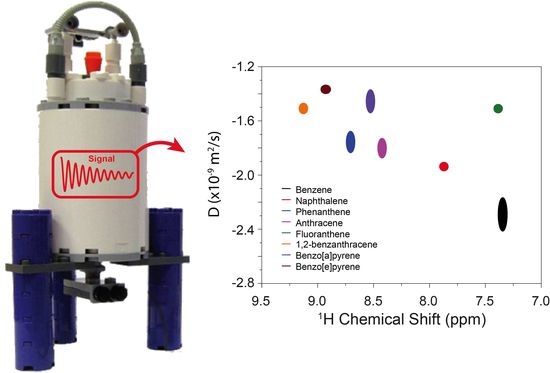Analysis of Polycyclic Aromatic Hydrocarbon (PAH) Mixtures Using Diffusion-Ordered NMR Spectroscopy and Adsorption by Powdered Activated Carbon and Biochar
Abstract
:1. Introduction
2. Experiments
2.1. Chemicals and Materials
2.2. NMR Spectroscopy
3. Results and Discussion
3.1. 1H NMR Spectra of Polycyclic Aromatic Hydrocarbons
3.2. Measuring Diffusion Coefficients of Polycyclic Aromatic Hydrocarbons Using DOSY
3.3. Analysis of PAH Mixtures Using NMR Spectroscopy
3.4. Isothermal Adsorption
4. Conclusions
Author Contributions
Conflicts of Interest
References
- Mastrangelo, G.; Fadda, E.; Marzia, V. Polycyclic aromatic hydrocarbons and cancer in man. Environ. Health Pers. 1996, 104, 1166–1170. [Google Scholar] [CrossRef]
- Dat, N.-D.; Chang, M.B. Review on characteristics of PAHs in atmosphere, anthropogenic sources and control technologies. Sci. Total Environ. 2017, 609, 682–693. [Google Scholar] [CrossRef] [PubMed]
- Zhang, P.; Chen, Y. Polycyclic aromatic hydrocarbons contamination in surface soil of China: A review. Sci. Total Environ. 2017, 605–606, 1011–1020. [Google Scholar] [CrossRef] [PubMed]
- Rengarajan, T.; Rajendran, P.; Nandakumar, N.; Lokeshkumar, B.; Rajendran, P.; Nishigaki, I. Exposure to polycyclic aromatic hydrocarbons with special focus on cancer. Asian Pac. J. Trop Biomed. 2015, 5, 182–189. [Google Scholar] [CrossRef]
- Boffetta, P.; Jourenkova, N.; Gustavsson, P. Cancer risk from occupational and environmental exposure to polycyclic aromatic hydrocarbons. Cancer Causes Ctrl. 1997, 8, 444–472. [Google Scholar] [CrossRef]
- Korsh, J.; Shen, A.; Aliano, K.; Davenport, T. Polycyclic Aromatic Hydrocarbons and Breast Cancer: A Review of the Literature. Breast Care 2015, 10, 316–318. [Google Scholar] [CrossRef] [PubMed]
- Wenzl, T.; Simon, R.; Anklam, E.; Kleiner, J. Analytical methods for polycyclic aromatic hydrocarbons (PAHs) in food and the environment needed for new food legislation in the European Union. TRAC Trends Anal. Chem. 2006, 25, 716–725. [Google Scholar] [CrossRef]
- Paulik, L.B.; Donald, C.E.; Smith, B.W.; Tidwell, L.G.; Hobbie, K.A.; Kincl, L.; Haynes, E.N.; Anderson, K.A. Emissions of Polycyclic Aromatic Hydrocarbons from Natural Gas Extraction into Air. Environ. Sci. Technol. 2016, 50, 7921–7929. [Google Scholar] [CrossRef] [PubMed]
- Lee, S.-Y.; Lee, J.-Y.; Shin, H.-S. Evaluation of Chemical Analysis Method and Determination of Polycyclic Aromatic Hydrocarbons Content from Seafood and Dairy Products. Toxicol. Res. 2015, 31, 265–271. [Google Scholar] [CrossRef] [PubMed]
- Simpson, A.J.; Simpson, M.J.; Soong, R. Nuclear Magnetic Resonance Spectroscopy and Its Key Role in Environmental Research. Environ. Sci. Technol. 2012, 46, 11488–11496. [Google Scholar] [CrossRef] [PubMed]
- Cardoza, L.A.; Korir, A.K.; Otto, W.H.; Wurrey, C.J.; Larive, C.K. Applications of NMR spectroscopy in environmental science. Prog. Nucl. Magn. Reson. Spectrosc. 2004, 45, 209–238. [Google Scholar] [CrossRef]
- Bliumkin, L.; Dutta Majumdar, R.; Soong, R.; Adamo, A.; Abbatt, J.P.D.; Zhao, R.; Reiner, E.; Simpson, A.J. Development of an in Situ NMR Photoreactor To Study Environmental Photochemistry. Environ. Sci. Technol. 2016, 50, 5506–5516. [Google Scholar] [CrossRef] [PubMed]
- Kitamaki, Y.; Saito, N.; Yamazaki, T.; Otsuka, S.; Nakamura, S.; Nishizaki, Y.; Sugimoto, N.; Numata, M.; Ihara, T. Determination of PAHs in Solution with a Single Reference Standard by a Combination of 1H Quantitative NMR Spectroscopy and Chromatography. Anal. Chem. 2017, 89, 6963–6968. [Google Scholar] [CrossRef] [PubMed]
- Rios, S.M.; Barquín, M.; Nudelman, N.S. Characterization of oil complex hydrocarbon mixtures by HSQC-NMR spectroscopy and PCA. J. Phys. Org. Chem. 2013, 27, 352–357. [Google Scholar] [CrossRef]
- Komatsu, T.; Kobayashi, T.; Hatanaka, M.; Kikuchi, J. Profiling Planktonic Biomass Using Element-Specific, Multicomponent Nuclear Magnetic Resonance Spectroscopy. Environ. Sci. Technol. 2015, 49, 7056–7062. [Google Scholar] [CrossRef] [PubMed]
- Minor, E.C.; Swenson, M.M.; Mattson, B.M.; Oyler, A.R. Structural characterization of dissolved organic matter: A review of current techniques for isolation and analysis. Environ. Sci. Proc. Impacts 2014, 16, 2064–2079. [Google Scholar] [CrossRef] [PubMed]
- Loening, N.M.; Keeler, J.; Morris, G.A. One-Dimensional DOSY. J. Magn. Reson. 2001, 153, 103–112. [Google Scholar] [CrossRef] [PubMed]
- Morris, K.F.; Johnson, C.S. Diffusion-ordered two-dimensional nuclear magnetic resonance spectroscopy. J. Am. Chem. Soc. 1992, 114, 3139–3141. [Google Scholar] [CrossRef]
- Kapur, G.S.; Findeisen, M.; Berger, S. Analysis of hydrocarbon mixtures by diffusion-ordered NMR spectroscopy. Fuel 2000, 79, 1347–1351. [Google Scholar] [CrossRef]
- Bax, A.; Ferretti, J.A.; Nashed, N.; Jerina, D.M. Complete 1H and 13C NMR assignment of complex polycyclic aromatic hydrocarbons. J. Org. Chem. 1985, 50, 3029–3034. [Google Scholar] [CrossRef]
- Lutnaes, B.F.; Luthe, G.; Brinkman, U.A.T.; Johansen, J.E.; Krane, J. Characterization of monofluorinated polycyclic aromatic compounds by 1H,13C and 19F NMR spectroscopy. Magn. Reson. Chem. 2005, 43, 588–594. [Google Scholar] [CrossRef] [PubMed]
- Tanner, J.E.; Stejskal, E.O. Restricted Self-Diffusion of Protons in Colloidal Systems by the Pulsed-Gradient, Spin-Echo Method. J. Chem. Phys. 1968, 49, 1768–1777. [Google Scholar] [CrossRef]
- David, H.; Jin, Z.; Chen, C.; Westerhoff, P. Adsorption of N-nitrosodimethylamine precursors by powdered and granular activated carbon. Environ. Sci. Technol. 2012, 46, 12630–12639. [Google Scholar]




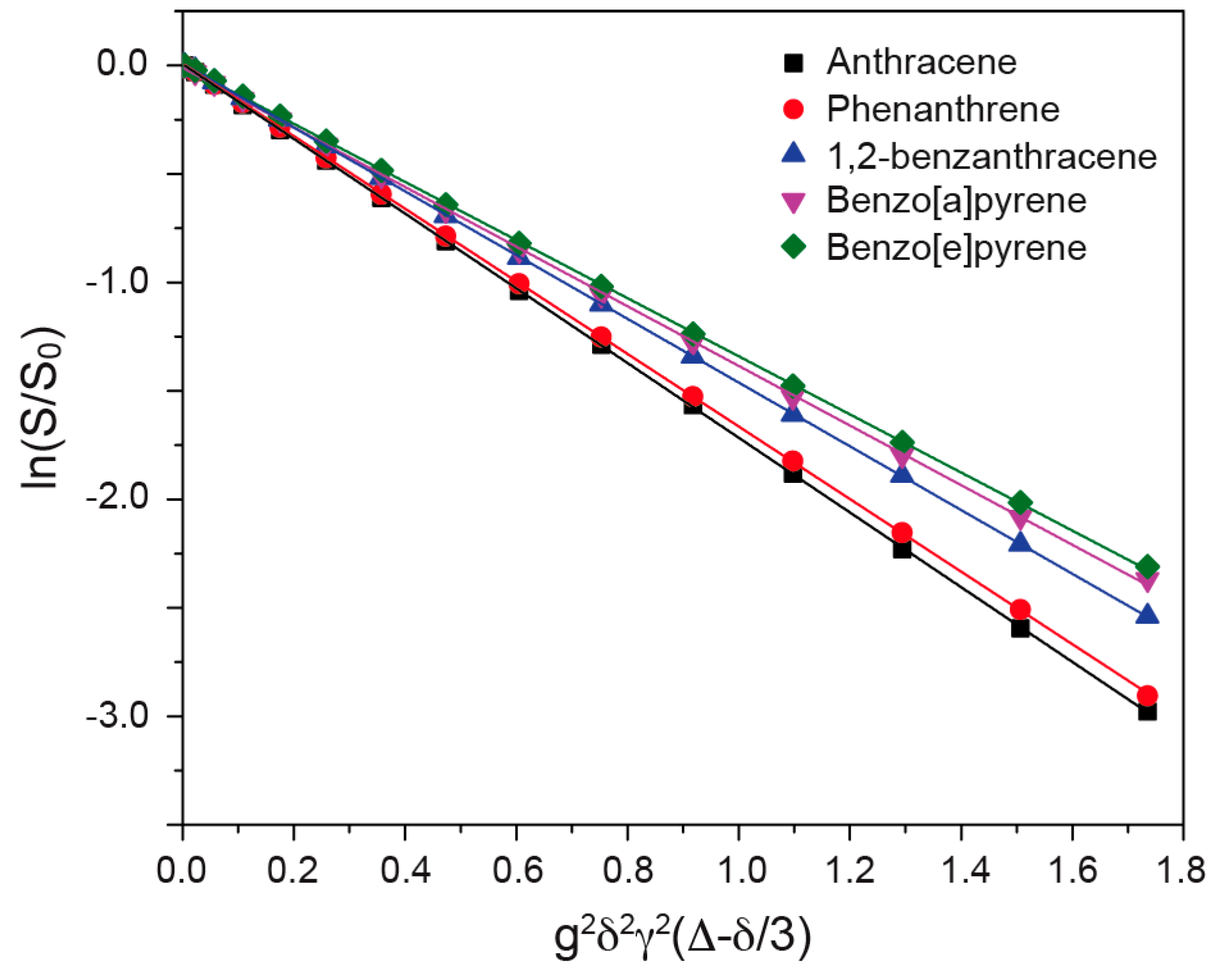
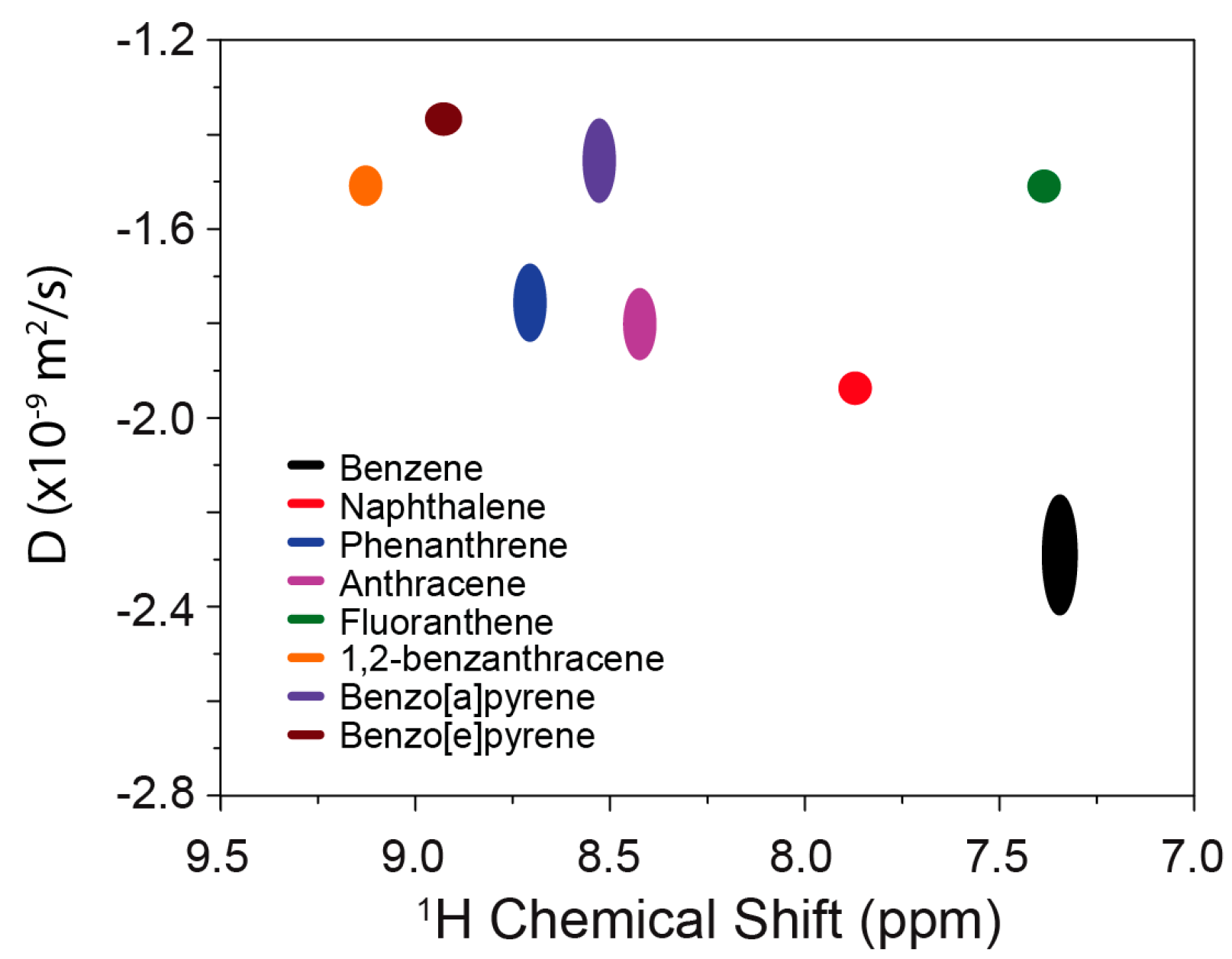
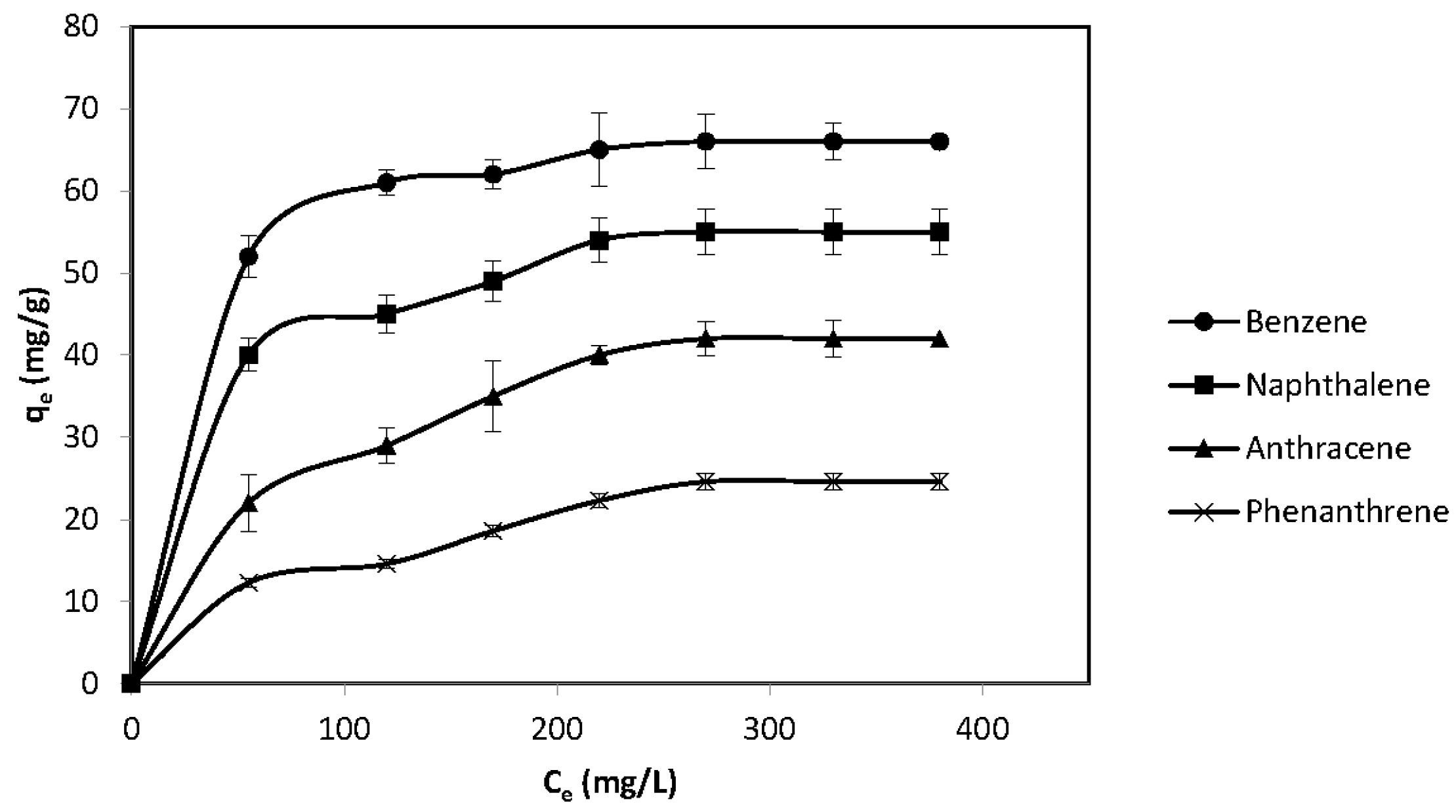
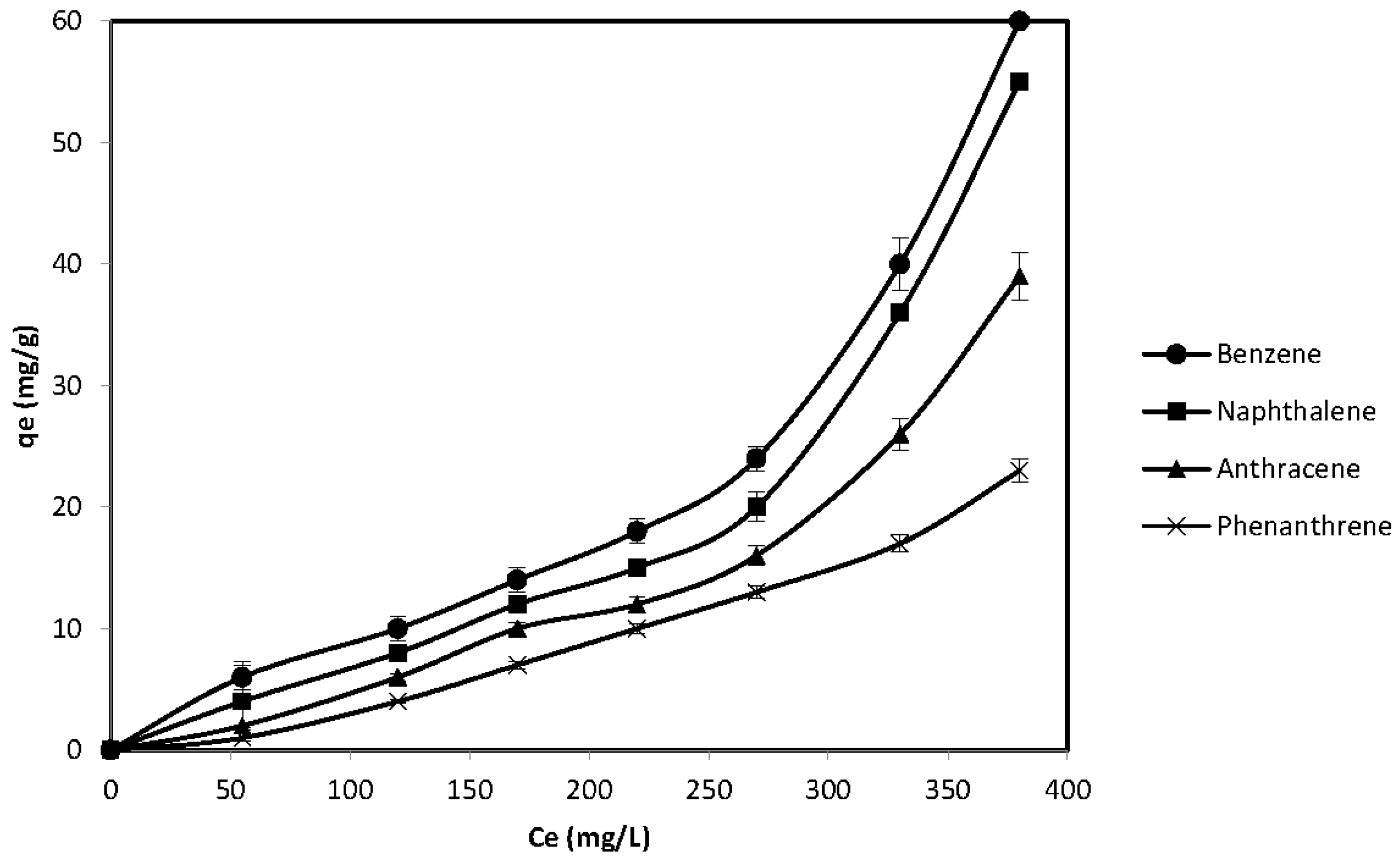
| Adsorbent | Iodine Number (mg/g) | Methylene Number (mg/g) | BET Sufface Area (m2/g) |
|---|---|---|---|
| Wood-based PAC | 910 | 120 | 1100 |
| Biochar | 1400 | 95 | 880 |
| Solutes | Integration Region (ppm) | Single (m2/s) × 109 | Mixture A (m2/s) × 109 | Mixture B (m2/s) × 109 | Mixture C (m2/s) × 109 |
|---|---|---|---|---|---|
| Benzene | 7.34~7.40 | 2.43 ± 0.02 | 2.20 ± 0.04 | - | - |
| Naphthalene | 7.81~7.88 | 1.93 ± 0.01 | 1.92 ± 0.01 | - | - |
| Phenanthrene | 8.67~8.75 | 1.83 ± 0.01 | 1.76 ± 0.01 | - | 1.67 ± 0.01 |
| Anthracene | 8.41~8.47 | 1.86 ± 0.01 | 1.77 ± 0.01 | - | 1.72 ± 0.01 |
| Fluoranthene | 7.35~7.43 | 1.53 ± 0.01 | - | - | - |
| 1,2-benzanthracene | 9.14~9.22 | 1.55 ± 0.01 | - | - | 1.47 ± 0.01 |
| Benzo[a]pyrene | 8.49~8.54 | 1.55 ± 0.01 | - | 1.47 ± 0.01 | 1.37 ± 0.01 |
| Benzo[e]pyrene | 8.88~8.95 | 1.40 ± 0.01 | - | 1.37 ± 0.01 | 1.34 ± 0.01 |
© 2018 by the authors. Licensee MDPI, Basel, Switzerland. This article is an open access article distributed under the terms and conditions of the Creative Commons Attribution (CC BY) license (http://creativecommons.org/licenses/by/4.0/).
Share and Cite
An, D.; Guo, C.; Chen, Y. Analysis of Polycyclic Aromatic Hydrocarbon (PAH) Mixtures Using Diffusion-Ordered NMR Spectroscopy and Adsorption by Powdered Activated Carbon and Biochar. Materials 2018, 11, 460. https://doi.org/10.3390/ma11040460
An D, Guo C, Chen Y. Analysis of Polycyclic Aromatic Hydrocarbon (PAH) Mixtures Using Diffusion-Ordered NMR Spectroscopy and Adsorption by Powdered Activated Carbon and Biochar. Materials. 2018; 11(4):460. https://doi.org/10.3390/ma11040460
Chicago/Turabian StyleAn, Dong, Chengchen Guo, and Yanan Chen. 2018. "Analysis of Polycyclic Aromatic Hydrocarbon (PAH) Mixtures Using Diffusion-Ordered NMR Spectroscopy and Adsorption by Powdered Activated Carbon and Biochar" Materials 11, no. 4: 460. https://doi.org/10.3390/ma11040460



